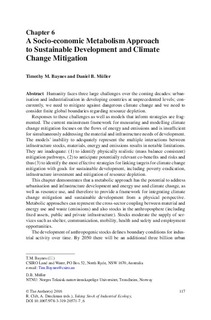| dc.description.sponsorship | Humanity faces three large challenges over the coming decades: urbanisation
and industrialisation in developing countries at unprecedented levels; concurrently,
we need to mitigate against dangerous climate change and we need to
consider fi nite global boundaries regarding resource depletion.
Responses to these challenges as well as models that inform strategies are fragmented.
The current mainstream framework for measuring and modelling climate
change mitigation focuses on the fl ows of energy and emissions and is insuffi cient
for simultaneously addressing the material and infrastructure needs of development.
The models’ inability to adequately represent the multiple interactions between
infrastructure stocks, materials, energy and emissions results in notable limitations.
They are inadequate: (1) to identify physically realistic (mass balance consistent)
mitigation pathways, (2) to anticipate potentially relevant co-benefi ts and risks and
thus (3) to identify the most effective strategies for linking targets for climate change
mitigation with goals for sustainable development, including poverty eradication,
infrastructure investment and mitigation of resource depletion.
This chapter demonstrates that a metabolic approach has the potential to address
urbanisation and infrastructure development and energy use and climate change, as
well as resource use, and therefore to provide a framework for integrating climate
change mitigation and sustainable development from a physical perspective.
Metabolic approaches can represent the cross-sector coupling between material and
energy use and waste (emissions) and also stocks in the anthroposphere (including
fi xed assets, public and private infrastructure). Stocks moderate the supply of services
such as shelter, communication, mobility, health and safety and employment
opportunities.
The development of anthropogenic stocks defi nes boundary conditions for industrial
activity over time. By 2050 there will be an additional three billion urban dwellers, almost all of them in developing countries. If they are to receive the level
of services converging on those currently experienced in developed nations, this
will entail a massive investment in infrastructure and substantial quantities of steel,
concrete and aluminium (materials that account for nearly half of industrial emissions).
This scenario is confronted by the legacy of existing infrastructure and the
limit of a cumulative carbon budget within which we could restrain global temperature
rise to <2 °C.
A metabolic framework incorporating stock dynamics can make an explicit connection
between the timing of infrastructure growth or replacement and the material
and energy needs of that investment. Moreover, it provides guidance on the technical
and systemic options for climate mitigation concurrent with a future of intense
urban development and industrialisation | nb_NO |
